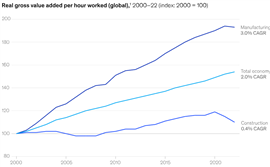7 things that are blocking productivity gains in construction
23 September 2024
 Image: CinimaticWorks via AdobeStock - stock.adobe.com
Image: CinimaticWorks via AdobeStock - stock.adobe.com
Construction’s age-old productivity problem persists and if a solution isn’t found then it could cause pain not just for the industry but for entire economies.
That’s the warning to come out of a recent report by global management consulting company McKinsey, which has built on a 2017 study that examined the issue of construction productivity, and highlights the growing urgency to find a solution.
McKinsey said that the global construction industry could grow by 70% by 2040 but that there was “no evidence” that a labour market would be able to keep up with demand, in light of the fact that construction companies in many parts of the world are already struggling to find enough skilled workers to deliver today’s pipeline.
Given that construction companies won’t simply be able to hire more workers to meet demand, the answer should lie in improving the economic value added to the industry per hour worked.
 Productivity in construction continues to lag other sectors according to McKinsey’s analysis of data from 42 countries (Source: McKinsey & Company)
Productivity in construction continues to lag other sectors according to McKinsey’s analysis of data from 42 countries (Source: McKinsey & Company)
If not, the danger is that there could be a shortfall in construction output of $40 trillion by 2040 if productivity remains stagnant, according to McKinsey.
But unfortunately, productivity has flatlined, even in the face of efforts by some individual companies. Construction productivity increased by only 10% between 2000 and 2022 (the equivalent of 0.4% a year), according to calculations by McKinsey based on multiple sources. Over the same period, productivity in the total economy increased 50% (2% annually) and the manufacturing sector enjoyed a 90% increase (3% annually).
And the consultancy identified seven specific issues that are holding back productivity gains in construction. They are:
- Slow technology uptake, focused on control not productivity: Construction companies have historically spent less than 1% of revenue on IT, which is a third of what is common in industries like aerospace and automotive. Interest in technology within the sphere of architecture, engineering and construction (AEC) has grown since 2020 and venture capital and private equity funds invested $50 billion in AEC technologies globally between 2020 and 2022, according to McKinsey analysis. However, that has not yet led to a boost in productivity, McKinsey’s report claimed. It also suggested that technologies that have so far been adopted at scale, like digital document management and building information modelling have not yet typically been deployed “in a way that would fundamentally transform ways of working for the majority of workers”. Other technologies like prefabrication and supply chain marketplaces are not yet delivering at scale, the report contended.
- Construction struggles to scale improvements: While efforts may be underway to improve projects, it can be difficult to translate those improvements to the whole project portfolio, McKinsey’s report asserted. That’s because project teams foster their own ways of working and may prove resistant to adapt to change or take on board new learnings from outside. Project team leaders may also be wary of piloting improvements that dip into tightly managed resources.
- Construction has passed on results of improvements: McKinsey’s report also claimed that where construction companies have improved productivity, they have often passed these benefits upwards to suppliers or downwards to customers. It cited the example of modular homes where customers expect lower prices or faster delivery, with construction companies continuing to feel the squeeze on profit margins.
- Contractual model and low margins stifle investment: The report continued on the theme of tight margins to highlight the fact that this makes it hard for construction companies to invest. Gains from productivity improvements get factored into cost estimates within proposals. And low margins contribute to caution about investing in further productivity improvements.
- Complex projects exposing companies to more risk: With an increasing share of brownfield sites in construction, projects are becoming more complex. Meanwhile, lowest bids are often the winning bids in a tender process and lump sum contracts remain prominent. McKinsey’s report argued that this leads to contractors mispricing and mismanaging risk and that owners and construction companies need to factor in, reduce, and manage complications to increase the predictability of outcomes and productivity.
- Lack of skilled workers: A lack of skilled workers means bringing in experienced replacements onto projects. Increased training for and control of new workers means reduced rates of productivity, the report claimed.
- Productivity not a prime metric: With companies under pressure to hit the delivery date for a project, productivity is rarely a priority for them, the report said. “Improving productivity and reducing idle times across all subcontractors and tasks while meeting throughput requirements would require systemwide efforts to improve workflows, reduce bottlenecks and variability, balance loads, and improve project production rates,” it said. But it added that managing these additional factors could prove difficult, especially on larger projects.
Recommendations
For construction companies to increase productivity, McKinsey recommended first a series of foundational measures ahead of more transformative approaches. The foundational measures included:
- Setting up teams for success, including adequate staffing
- Robust planning and design
- Fewer and better handovers
- Apprenticing of capable people
For a step change in productivity (which McKinsey plans to explore further in future reports), it recommended:
- Adopting new forms of project steering focused on production rate metrics, similar to manufacturing
- Nurturing a supplier ecosystem across projects
- Upskilling project staff with systematic apprenticeships and project academies focused on hard and soft skills
- Scale initiatives across project portfolios
- Apply technology to have a direct impact on productivity.
STAY CONNECTED



Receive the information you need when you need it through our world-leading magazines, newsletters and daily briefings.
CONNECT WITH THE TEAM








